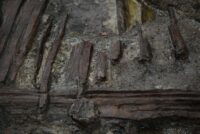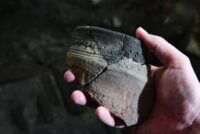 The remains of an early medieval structure under the Main Town Hall of Gdańsk has rolled back the date of the founding of the city 60 years to the early 10th century. An archaeological excavation of the cellars of the former mayoral seat undertaken between September and December of this year uncovered fragments of Slavic ceramics and timbers used in the early city’s defensive ramparts. The style of ceramics is typical of the first half of the 10th century, and dendrochronological analysis of the timbers dates them to 930 A.D.
The remains of an early medieval structure under the Main Town Hall of Gdańsk has rolled back the date of the founding of the city 60 years to the early 10th century. An archaeological excavation of the cellars of the former mayoral seat undertaken between September and December of this year uncovered fragments of Slavic ceramics and timbers used in the early city’s defensive ramparts. The style of ceramics is typical of the first half of the 10th century, and dendrochronological analysis of the timbers dates them to 930 A.D.
There is evidence of settlement in the Vistula delta area going back to the Neolithic (2500-1700 B.C.) and remains from the Lusatian culture (ca. 1200-500 B.C.) and Roman period have been discovered under modern-day Gdańsk. Its location on the Baltic Sea made it a trade stop on the ancient Amber Road. The modern city of Gdańsk was believed to have been founded around 980 A.D. by Mieszko I, Duke of Poland from 960 until his death in 992 and the first ruler of Poland as an independent state. He was the first of the Piast dynasty (named after their legendary 8th century ancestor Piast the Wheelwright) to rule Poland. Mieszko’s His son and heir would become the first crowned king of Poland, Bolesław I the Brave (c. 967-1025).
 Archaeological discoveries made under and around Town Hall in the 70s also revealed wooden remains which archaeologist Andrzej Zbierski believed were sections of a 10th century rampart. His assessment was not accepted by archaeologists and historians at the time. This summer, the excavation team reopened Zbierski’s trenches from more than 50 years ago and took samples of the wood remains. Radiocarbon dating narrowed the dates to between 911 and 951, and dendrochronological analysis found the timbers were harvested in the year 930.
Archaeological discoveries made under and around Town Hall in the 70s also revealed wooden remains which archaeologist Andrzej Zbierski believed were sections of a 10th century rampart. His assessment was not accepted by archaeologists and historians at the time. This summer, the excavation team reopened Zbierski’s trenches from more than 50 years ago and took samples of the wood remains. Radiocarbon dating narrowed the dates to between 911 and 951, and dendrochronological analysis found the timbers were harvested in the year 930.
Museum officials informed that the finds will be secured and then buried. The director of the museum emphasized that the remains of the embankment have survived to our times only because of favorable circumstances.
“Firstly, no one destroyed them in the 14th century, perhaps because they stabilized structures erected on a wetland. Secondly, the embankment is in peat, which perfectly preserves organic material” – explained Prof. Ossowski. And as the third reason, he gave that the find was found in a wetland, and the water – according to the professor – also preserves the wood intact.
He also indicated that sharing the find would be associated with high risk. “There is high humidity in the cellars, additionally, in the summer months, groundwater enters the excavation, which rises to such an extent that it will make it impossible to clearly expose the wooden remains” – he assessed.
He added that such a valuable find would be best buried for now, so that it would survive in the state in which it has survived for over 1,000 years until there is an idea how to show it to visitors permanently and without risk.
Traces of settlement will be additionally secured with geotextile.